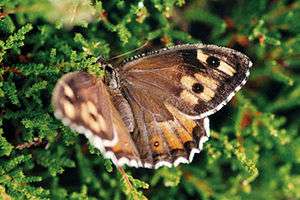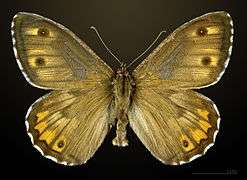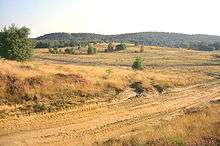Grayling (butterfly)
| Grayling | |
|---|---|
 | |
| Female | |
.jpg) | |
| Underside, Greenham Common, Berkshire | |
| Scientific classification | |
| Kingdom: | Animalia |
| Phylum: | Arthropoda |
| Class: | Insecta |
| Order: | Lepidoptera |
| Family: | Nymphalidae |
| Genus: | Hipparchia |
| Species: | H. semele |
| Binomial name | |
| Hipparchia semele (Linnaeus, 1758) | |
The grayling, or rock grayling, (Hipparchia semele) is a species in the brush-footed butterfly family Nymphalidae.
Description
 Male
Male Male underside
Male underside Female
Female Female underside
Female underside
Distribution
It is found in Europe below 63°N eastwards to extreme western Russia. It is absent from Albania, Macedonia and South Greece.In the north of its range it is coastal for some reason and in the South of its range it is replaced by other Hipparchia species. They are only slightly different and together with semele form a cryptic species complex - Hipparchia aristaeus, Hipparchia christenseni, Hipparchia cretica, Hipparchia mersina, Hipparchia pellucida, Hipparchia volgensis.[1]
Habitat

Coast, dunes, salt marsh, undercliffs, clifftops, dry heathland, calcareous grassland, old quarries, earthworks, derelict old spoil heaps, open woodland on stony ground, dry and well-drained soil, with sparse vegetation and plenty of bare ground in open, sunny, positions.
Biology
Life cycle
Note that information on this species applies to Great Britain and some details may not be consistent with the species in other parts of its range.
There is one generation. The eggs are laid from July to September singly on the food plant.The eggs are white at first, but turn pale yellow. The egg stage lasts between 2 and 3 weeks. The first instar and second instar larva feed in mid to late summer and then hibernate (while still small), in the 3rd instar, at the base of the tussock. Feeding resumes in the spring and the last instar larvae are nocturnal,hiding in the base of grass tussocks during the day. There are 4 moults in total.The pupa is unattached, in an earth cell. The pupal stage lasts around 4 weeks. The larval instars are August to June,the pupa is formed June to August and the adult flies June to August.
 egg
egg larva
larva_Greenham.jpg)
.jpg)
_male.jpg) Male of unclassified sub-species, Portugal
Male of unclassified sub-species, Portugal
Larval host plants
- Sheep's-fescue Festuca ovina
- Red fescue Festuca rubra
- Bristle bent Agrostis curtisii
- Early hair-grass Aira praecox
- Tufted hair-grass Deschampsia cespitosa
- Marram Ammophila arenaria
- Upright brome Bromus erectus
- Slim-stem reed grass Calamagrostis neglecta
- Grey hair-grass Corynephorus canescens
- Cock's-foot Dactylis glomerata
- Couch grassElymus repens
- Agropyron species
- Triticum species
Behaviour
.jpg)
They rest with closed wings, forewings lowered between the hindwings as do many Satyrinae. When disturbed, they raise the forewing so that the large eyespots near its apex become visible. A predator attacking the butterfly could either be startled by the sudden appearance of the pattern, or be enticed into attacking the conspicuous spot rather than the butterfly's body (Stevens, 2005).
Males are territorial and show courtship behaviour. Both sexes are nectar-feeding .
Conservation (Great Britain)
It is now a UK BAP species (Butterfly Conservation, 2007).
References
- ↑ Tolman, Tom & Lewington, Richard (2008): Collins Butterfly Guide. Collins Publishers. London. 384 pp.
- Butterfly Conservation (2007), Priority butterfly species listed in the UK Biodiversity Action Plan 2007, Butterfly Conservation, Wareham, UK. 1p.
- Stevens, Martin (2005): The role of eyespots as anti-predator mechanisms, principally demonstrated in the Lepidoptera. Biol. Rev. 80(4): 573–588. doi:10.1017/S1464793105006810 (HTML abstract)
External links
| Wikimedia Commons has media related to Hipparchia semele. |
- Butterfly Conservation Website
- UK Butterflies Website - includes a list of sites around the UK where this species can be found